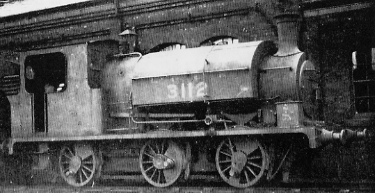The E&WYUR J84 0-6-0T Locomotives

The East & West Yorkshire Union Railway (E&WYUR) was a short 9 mile line that served collieries in the area south of Leeds. When it was taken over by the LNER on 1st July 1923, its locomotive stock consisted of four 0-6-0STs (LNER J84 and J85) and two 0-6-2STs (LNER N19). All were built by the local Leeds company of Manning Wardle & Co. The 0-6-0ST classifications duplicated the classifications already allocated to two Wheatley-designed North British Railway locomotive types (NBR J84 and J85). However the duplication ceased when the NBR locomotives were withdrawn in 1924.
The J84 classification was used for E&WYUR Nos. 1-3. These had 17in x24in cylinders and 4ft coupled wheels. The firebox was raised so that the top of the firebox was almost level with the top of the water tank. The raised fireboxes were a deliberate design feature for use on the E&WYUR's steep routes. Nos. 1 & 2 were delivered in 1895. No. 3 was delivered in September 1900 and differed in minor details such as a whistle with a deeper tone.
Within weeks of entering LNER ownership, No. 3 was quickly withdrawn. Nos. 1 & 2 were renumbered as 3112 & 3113.
The original boilers appear to have been particularly short-lived. All three engines had new boilers fitted between 1911 and 1914. These new boilers remained with the engines until they were withdrawn. No. 2 was rebuilt with longer frames in 1915. These frames were 6in longer and also thicker. After the rebuild, No. 2 experienced multiple frame fractures. Although this might be attributed to the loss of flexibility on the E&WYUR's notoriously sharp curves, it should be noted that No. 4 (Class J85) did not experience these problems.
The only other modification of significance, was the fitting of coal rails early in their lives. This increased the bunker capacity from 1 ton to 1 ton 10cwt.
These locomotives worked their entire lives hauling coal on the E&WYUR line. The E&WYUR operated a short-lived passenger service during 1904. Although these were initially operated by a Midland 0-4-4T, they were later taken over by No. 1. For these workings, a vacuum ejector was fitted. The ejector was removed before No. 1 entered LNER ownership.
No. 3113 was withdrawn in 1928, and No. 3112 lasted slightly longer to 1930. All of the E&WYUR engines were strongly built, and well suited to the line's notoriously steep and sharp branch lines. The LNER had a lot of trouble replacing the E&WYUR locomotives after their withdrawal. Various types were tried, but it was only in the late 1930s that ex-GER J69s were found to be suitable.
Technical Details
The following details refer to Nos. 3112 and E&WYUR No. 3. No. 3113 was longer and heavier.
| Cylinders (x2): | (inside) | 17x24in. |
| Motion: | Stephenson | |
| Valves: | Slide | |
| Boiler: | Diameter (max): | 4ft |
| Length: | 10ft | |
| Boiler Pressure: | 150psi | |
| Heating Surface: | Total: | 963 sq.ft. |
| Firebox: | 95 sq.ft. | |
| Tubes: | 868 sq.ft. (172x 1.87in dia.) | |
| Grate Area: | 14.94 sq.ft. | |
| Wheels: | 4ft | |
| Total Wheelbase: | 14ft 6in | |
| Tractive Effort: | (at 85%) | 18,424 lb |
| Length: | 29ft 3in | |
| Weight: | 39t 12cwt | |
| Max. Axle Load: | 13t 19cwt | |
| Water Capacity: | 850 gallons | |
| Coal Capacity: | 1t 10cwt |
Preservation
None of the E&WYUR J84s survived into preservation.
Models
I am not aware of any models of the E&WYUR J84s in any scale.